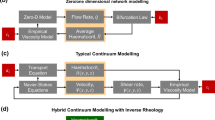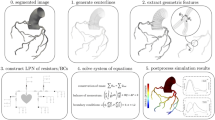Abstract
We developed a mathematical model to simulate shear stress-dependent nitric oxide (NO) production and transport in a 3D microcirculatory network based on published data. The model consists of a 100 μm × 500 μm × 75 μm rectangular volume of tissue containing two arteriole-branching trees, and nine capillaries surrounding the vessels. Computed distributions for NO in blood, vascular walls, and surrounding tissue were affected by hematocrit (Hct) and wall shear stress (WSS) in the network. The model demonstrates that variations in the red blood cell (RBC) distribution and WSS in a branching network can have differential effects on computed NO concentrations due to NO consumption by RBCs and WSS-dependent changes in NO production. The model predicts heterogeneous distributions of WSS in the network. Vessel branches with unequal blood flow rates gave rise to a range of WSS values and therefore NO production rates. Despite increased NO production in a branch with higher blood flow and WSS, vascular wall NO was predicted to be lower due to greater NO consumption in blood, since the microvascular Hct increased with redistribution of RBCs at the vessel bifurcation. Within other regions, low WSS was combined with decreased NO consumption to enhance the NO concentration.










Similar content being viewed by others
References
Ando J, Yamamoto K (2009) Vascular mechanobiology: endothelial cell responses to fluid shear stress. Circ J 73(11):1983–1992
Arciero JC, Carlson BE, Secomb TW (2008) Theoretical model of metabolic blood flow regulation: roles of ATP release by red blood cells and conducted responses. Am J Physiol Heart Circ Physiol 295(4):H1562–H1571
Bohlen HG (1998) Mechanism of increased vessel wall nitric oxide concentrations during intestinal absorption. Am J Physiol 275(2 Pt 2):H542–H550
Buerk DG (2001) Can we model nitric oxide biotransport? A survey of mathematical models for a simple diatomic molecule with surprisingly complex biological activities. Annu Rev Biomed Eng 3:109–143
Buerk DG (2007) Nitric oxide regulation of microvascular oxygen. Antioxid Redox Signal 9(7):829–843
Buerk DG, Lamkin-Kennard K, Jaron D (2003) Modeling the influence of superoxide dismutase on superoxide and nitric oxide interactions, including reversible inhibition of oxygen consumption. Free Radic Biol Med 34(11):1488–1503
Butler AR, Megson IL, Wright PG (1998) Diffusion of nitric oxide and scavenging by blood in the vasculature. Biochim Biophys Acta 1425(1):168–176
Carlsen E, Comroe JH (1958) The rate of uptake of carbon monoxide and of nitric oxide by normal human erythrocytes and experimentally produced spherocytes. J Gen Physiol 42(1):83–107
Carlson BE, Arciero JC, Secomb TW (2008) Theoretical model of blood flow autoregulation: roles of myogenic, shear-dependent, and metabolic responses. Am J Physiol Heart Circ Physiol 295(4):H1572–H1579
Carr RT, Lacoin M (2000) Nonlinear dynamics of microvascular blood flow. Ann Biomed Eng 28(6):641–652
Chen X, Buerk DG, Barbee KA, Jaron D (2007) A model of NO/O2 transport in capillary-perfused tissue containing an arteriole and venule pair. Ann Biomed Eng 35(4):517–529
Chen X, Jaron D, Barbee KA, Buerk DG (2006) The influence of radial RBC distribution, blood velocity profiles, and glycocalyx on coupled NO/O2 transport. J Appl Physiol 100(2):482–492
Chien S (2008) Effects of disturbed flow on endothelial cells. Ann Biomed Eng 36(4):554–562
Comerford A, Plank MJ, David T (2008) Endothelial nitric oxide synthase and calcium production in arterial geometries: an integrated fluid mechanics/cell model. J Biomech Eng 130(1):011010
Cornelissen AJ, Dankelman J, VanBavel E, Spaan JA (2002) Balance between myogenic, flow-dependent, and metabolic flow control in coronary arterial tree: a model study. Am J Physiol Heart Circ Physiol 282(6):H2224–H2237
Davis MJ, Ferrer PN, Gore RW (1986) Vascular anatomy and hydrostatic pressure profile in the hamster cheek pouch. Am J Physiol 250(2 Pt 2):H291–H303
Ellsworth ML, Pittman RN (1990) Arterioles supply oxygen to capillaries by diffusion as well as by convection. Am J Physiol 258(4 Pt 2):H1240–H1243
Ellsworth ML, Popel AS, Pittman RN (1988) Assessment and impact of heterogeneities of convective oxygen transport parameters in capillaries of striated muscle: experimental and theoretical. Microvasc Res 35(3):341–362
Fung YC (1997) Biomechanics: circulation. New York, Springer-Verlag
Goldman D, Popel AS (2000) A computational study of the effect of capillary network anastomoses and tortuosity on oxygen transport. J Theor Biol 206(2):181–194
Hoogstraten HW, Kootstra JG, Hillen B, Krijger JK, Wensing PJ (1996) Numerical simulation of blood flow in an artery with two successive bends. J Biomech 29(8):1075–1083
House SD, Lipowsky HH (1987) Microvascular hematocrit and red cell flux in rat cremaster muscle. Am J Physiol 252(1 Pt 2):H211–H222
Hudlicka O, Brown MD, May S, Zakrzewicz A, Pries AR (2006) Changes in capillary shear stress in skeletal muscles exposed to long-term activity: role of nitric oxide. Microcirculation 13(3):249–259
Jensen FB (2009) The dual roles of red blood cells in tissue oxygen delivery: oxygen carriers and regulators of local blood flow. J Exp Biol 212(Pt 21):3387–3393
Jou LD, van Tyen R, Berger SA, Saloner D (1996) Calculation of the magnetization distribution for fluid flow in curved vessels. Magn Reson Med 35(4):577–584
Kavdia M, Popel AS (2003) Wall shear stress differentially affects NO level in arterioles for volume expanders and Hb-based O2 carriers. Microvasc Res 66(1):49–58
Kavdia M, Popel AS (2006) Venular endothelium-derived NO can affect paired arteriole: a computational model. Am J Physiol Heart Circ Physiol 290(2):H716–H723
Kleinbongard P, Keymel S, Kelm M (2007) New functional aspects of the l-arginine-nitric oxide metabolism within the circulating blood. Thromb Haemost 98(5):970–974
Kleinbongard P, Schulz R, Rassaf T, Lauer T, Dejam A, Jax T, Kumara I, Gharini P, Kabanova S, Ozuyaman B, Schnurch HG, Godecke A, Weber AA, Robenek M, Robenek H, Bloch W, Rosen P, Kelm M (2006) Red blood cells express a functional endothelial nitric oxide synthase. Blood 107(7):2943–2951
Kuchan MJ, Frangos JA (1994) Role of calcium and calmodulin in flow-induced nitric oxide production in endothelial cells. Am J Physiol 266(3 Pt 1):C628–C636
Kuo L, Davis MJ, Chilian WM (1995) Longitudinal gradients for endothelium-dependent and -independent vascular responses in the coronary microcirculation. Circulation 92(3):518–525
Lamkin-Kennard KA, Buerk DG, Jaron D (2004) Interactions between NO and O2 in the microcirculation: a mathematical analysis. Microvasc Res 68(1):38–50
Lamkin-Kennard KA, Jaron D, Buerk DG (2004) Impact of the Fahraeus effect on NO and O2 biotransport: a computer model. Microcirculation 11(4):337–349
Liao JC, Kuo L (1997) Interaction between adenosine and flow-induced dilation in coronary microvascular network. Am J Physiol 272(4 Pt 2):H1571–H1581
Mashour GA, Boock RJ (1999) Effects of shear stress on nitric oxide levels of human cerebral endothelial cells cultured in an artificial capillary system. Brain Res 842(1):233–238
Michel T, Vanhoutte PM (2010) Cellular signaling and NO production. Pflugers Arch 459(6):807–816
Nase GP, Tuttle J, Bohlen HG (2003) Reduced perivascular PO2 increases nitric oxide release from endothelial cells. Am J Physiol Heart Circ Physiol 285(2):H507–H515
Pries AR, Ley K, Claassen M, Gaehtgens P (1989) Red cell distribution at microvascular bifurcations. Microvasc Res 38(1):81–101
Pries AR, Secomb TW, Gaehtgens P (1990) Blood flow in microvascular networks. Experiments and simulation. Circ Res 67(4):826–834
Pries AR, Secomb TW, Gaehtgens P, Gross JF (1994) Resistance to blood flow in microvessels in vivo. Circ Res 75(5):904–915
Pries AR, Secomb TW, Gessner T, Sperandio MB, Gross JF, Gaehtgens P (1996) Biophysical aspects of blood flow in the microvasculature. Cardiovasc Res 32(4):654–667
Reber KM, Mager GM, Miller CE, Nowicki PT (2001) Relationship between flow rate and NO production in postnatal mesenteric arteries. Am J Physiol Gastrointest Liver Physiol 280(1):G43–G50
Sarelius IH, Damon DN, Duling BR (1981) Microvascular adaptations during maturation of striated muscle. Am J Physiol 241(3):H317–H324
Secomb TW, Hsu R (1994) Simulation of O2 transport in skeletal muscle: diffusive exchange between arterioles and capillaries. Am J Physiol 267(3 Pt 2):H1214–H1221
Sessa WC (2009) Molecular control of blood flow and angiogenesis: role of nitric oxide. J Thromb Haemost 7(Suppl 1):35–37
Thomas DD, Liu X, Kantrow SP, Lancaster JR Jr (2001) The biological lifetime of nitric oxide: implications for the perivascular dynamics of NO and O2. Proc Natl Acad Sci USA 98(1):355–360
Tsoukias NM (2008) Nitric oxide bioavailability in the microcirculation: insights from mathematical models. Microcirculation 15(8):813–834
Tsoukias NM, Popel AS (2003) A model of nitric oxide capillary exchange. Microcirculation 10(6):479–495
van Faassen EE, Bahrami S, Feelisch M, Hogg N, Kelm M, Kim-Shapiro DB, Kozlov AV, Li H, Lundberg JO, Mason R, Nohl H, Rassaf T, Samouilov A, Slama-Schwok A, Shiva S, Vanin AF, Weitzberg E, Zweier J, Gladwin MT (2009) Nitrite as regulator of hypoxic signaling in mammalian physiology. Med Res Rev 29(5):683–741
Vaughn MW, Kuo L, Liao JC (1998) Effective diffusion distance of nitric oxide in the microcirculation. Am J Physiol 274(5 Pt):H1705–H1714
Vaughn MW, Kuo L, Liao JC (1998) Estimation of nitric oxide production and reaction rates in tissue by use of a mathematical model. Am J Physiol 274(6 Pt 2):H2163–H2176
Vukosavljevic N, Jaron D, Barbee KA, Buerk DG (2006) Quantifying the l-arginine paradox in vivo. Microvasc Res 71(1):48–54
Zarins CK, Giddens DP, Bharadvaj BK, Sottiurai VS, Mabon RF, Glagov S (1983) Carotid bifurcation atherosclerosis. Quantitative correlation of plaque localization with flow velocity profiles and wall shear stress. Circ Res 53(4):502–514
Acknowledgments
This work was supported in part by HL 068164 from NIH and CBET 0730547 from NSF.
Author information
Authors and Affiliations
Corresponding author
Rights and permissions
About this article
Cite this article
Chen, X., Buerk, D.G., Barbee, K.A. et al. 3D network model of NO transport in tissue. Med Biol Eng Comput 49, 633–647 (2011). https://doi.org/10.1007/s11517-011-0758-7
Received:
Accepted:
Published:
Issue Date:
DOI: https://doi.org/10.1007/s11517-011-0758-7




